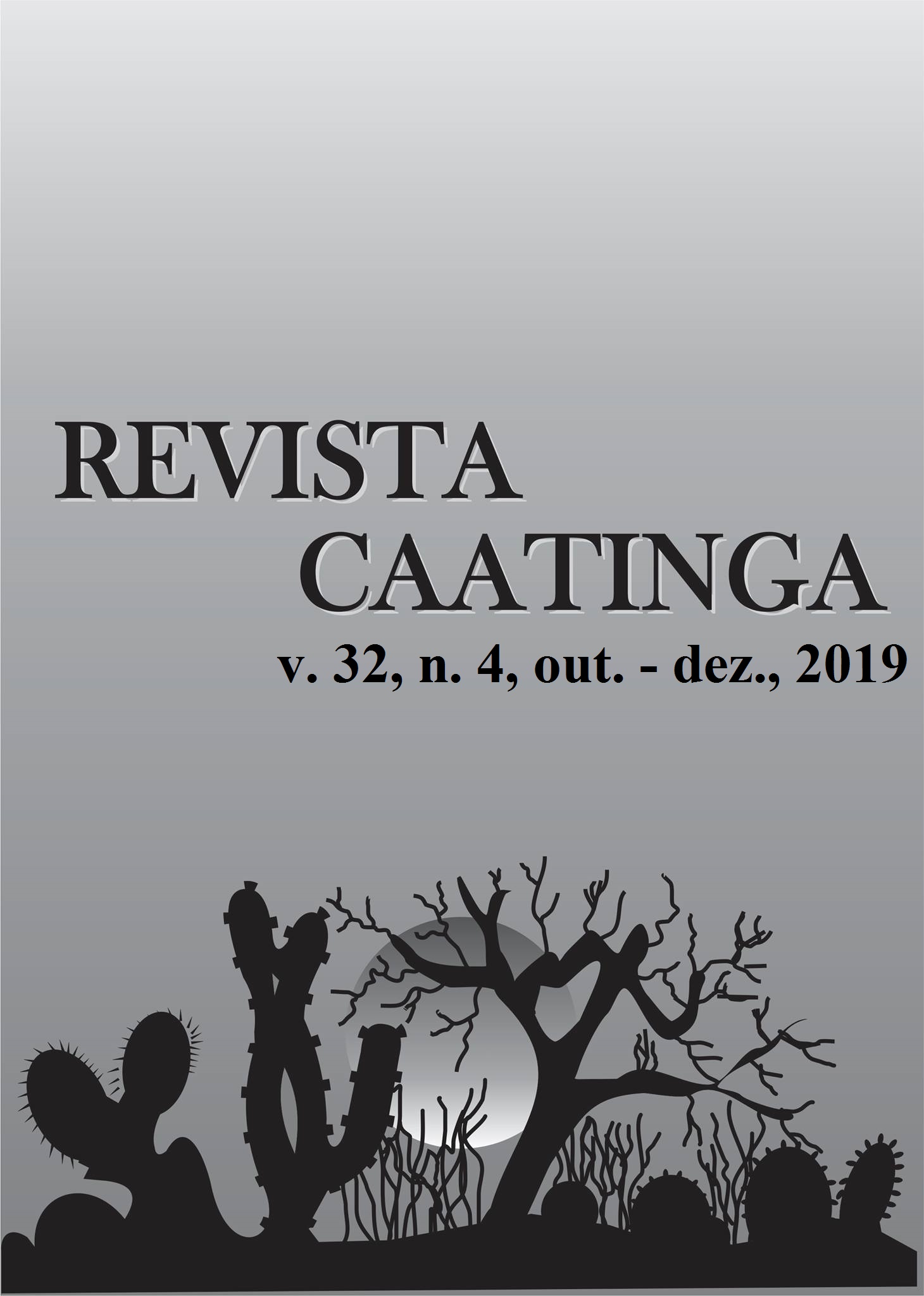AGRONOMIC PERFORMANCE OF CONTENDER AND AMARELO JAPONÊS CULTIVARS UNDER DIFFERENT WATER REPLACEMENTS
DOI:
https://doi.org/10.1590/1983-21252019v32n415rcKeywords:
Cultivation. Cerrado. Influence of irrigation. Green bean.Abstract
The use of cultivars appropriate to the soil and climate characteristics of a region provides farmers with security by facilitating credit for crop financing and improving product prices in local commerce. The objective of this work was to evaluate the agronomic performance of “Contender” and “Amarelo Japonês” green bean bush cultivars grown in the Cerrado in terms of water replenishment (RH) of 25, 50, 75, 100, and 125% of evaporation using the Piché evaporimeter. The experiment was carried out in the experimental area of the State University of Goiás, on the Ipameri Campus. The experimental design was a randomized block design. Sowing was done in May 2017, with treatments distributed in a split-plots scheme with water replenishment in plots and cultivar subplots with 3 replications. The analyzed variables were: height; stem diameter; leaf number; leaf area; number of inflorescences; number of flowers; fresh and dry mass of the plant; number, length, diameter, fresh and dry mass of the pods. The different water replenishment rates increased the mean plant height, stem diameter, number of pods per plant, number of bean seeds per pod, and number of bean seeds per plant in the cultivars “Amarelo Japonês” and “Contender.” Water replenishment of 125% produced higher development and better agronomic performance in the two cultivars than the other rates.
Downloads
References
CARVALHO, C. H. M. et al. de. Evolução do crescimento do cafeeiro (Coffea arábica L.) irrigado e não irrigado em duas densidades de plantio. Ciência e Agrotecnologia, v. 30, n. 2, p. 243-250, 2006.
EMPRESA BRASILEIRA DE PESQUISA AGROPECUÁRIA - EMBRAPA. Centro Nacional de Pesquisa de Solos. Sistema Brasileiro de Classificação de Solos. Rio de Janeiro: Embrapa, 2006. 306 p.
FERNANDES, E. J. Determinação do Índice De Estresse Hídrico em Cultura do Feijoeiro com Termômetro de Infravermelho. Irriga, v. 15, n. 3, p. 248-257, 2010.
FERREIRA, D. F. Sisvar: a computerstatistical analysis system. Ciência e Agrotecnologia, v. 35, n. 6, p. 1039-1042, 2011.
FIGUEIREDO, E. S.; SANTOS, M. E.; GARCIA, A. Modelos de Determinação Não Destrutivo da Área Foliar do Feijoeiro Comum (Phaseolus vulgaris L.). Nucleus, v. 9, n. 1, p.79-84, 2012.
FILGUEIRA, F. A. R. Novo manual de olericultura: agrotecnologia moderna na produção e comercialização de hortaliças. 3. ed. Viçosa, MG: UFV, 2013. 421 p.
FILGUEIRA, F. A. R. Novo manual de olericultura: agrotecnologia moderna na produção e comercialização de hortaliças. 2. ed. Viçosa: UFV, 2003. 412 p.
FILGUEIRA, F. A. R. Novo manual de olericultura: agrotecnologia moderna na produção e comercialização de hortaliças. 3. ed. Viçosa: UFV, 2008. 421 p.
HALAGALIMATH, S. P.; RAJKUMARA S.; Response of chicpea (Cicer arietinum L.) varieties to irrigation and hydrogel application in Vertisols. Legume Research: An International Journal, v. 41, n. 2, p. 259-263, 2018.
MANTOVANI, E. C.; BERNARDO, S.; PALARETTI, L. F. Irrigação princípios e métodos. 3.ed. Viçosa: UFV, 2009. 355 p.
MATHEUS, M. T.; LOPES, J. C. Morfologia de frutos, sementes e plântulas e germinação de sementes de Erythrina variegata L. Revista Brasileira de Sementes, v. 29, n. 3, p. 8-17, 2007.
MENDONÇA, F. C.; RASSINI, J. B. Temperatura-base inferior e estacionalidade de produção de gramíneas forrageiras tropicais. São Carlos, SP: Embrapa Pecuária Sudeste, 2006. 14 p. (Circular Técnica, 45).
MOREIRA, R. M. P. et al. Potencial agronômico e divergência genética entre genótipos de feijão-vagem de crescimento determinado Agronomic potential andgenetic divergence among genotypes of bush snap bean. Semina: Ciências Agrárias, v. 30, sup., p. 1051-1060, 2009.
OLIVEIRA S. R. M. Densidade populacional do feijão-caupi sob níveis de irrigação. 2013. 104 fls. Dissertação (Mestrado em Engenharia Agrícola: Área de Concentração Irrigação e Drenagem) - Universidade Federal do Ceará, Fortaleza, 2013.
PEEL, M. C.; FINLAYSON, B. L.; MCMAHON, T. A. Updated World Map of the Köppen-Geiger Climate Classification. Hydrol. Hydrology and Earth System Sciences Discussions , v. 11, n. 5, p. 1633-1644, 2007.
PEIXOTO, C. P. et al. Efeitos de épocas de semeadura e densidade de plantas sobre a produtividade de cultivares de soja no Estado de São Paulo. Revista de Agricultura, v. 77, n. 2, p. 265-291, 2002.
PEIXOTO, N.; CARDOSO, A. I. I.; Feijão-vagem. In: NASCIMENTO W. M. N. (ed.). Hortaliças leguminosas. Brasília: EMBRAPA, 2016. p. 61-86.
SILVESTRE, W. V. D. et al. Morphological andphysiological responses of acai seedlings subjected to different watering regimes/Respostas morfológicas e fisiológicas de mudas de açaizeiros submetidas a diferentes regimes hídricos. Revista Brasileira de Engenharia Agrícola e Ambiental, v. 20, n. 4, p. 364-371, 2016.
TAIZ, L. et al. Fisiologia do Desenvolvimento vegetal. 6. Ed. Porto Alegre, RS: Artmed, 2017. 888 p.
ZHANG, J. et al. W. Photosynthetic performance of soy bean plants to water deficit under high and low light intensity. South African Journal of Botany, v. 105, s/n, p. 279-287, 2016.
Downloads
Published
Issue
Section
License
Os Autores que publicam na Revista Caatinga concordam com os seguintes termos:
a) Os Autores mantêm os direitos autorais e concedem à revista o direito de primeira publicação, com o trabalho simultaneamente licenciado sob a Licença Creative Commons do tipo atribuição CC-BY, para todo o conteúdo do periódico, exceto onde estiver identificado, que permite o compartilhamento do trabalho com reconhecimento da autoria e publicação inicial nesta revista, sem fins comerciais.
b) Os Autores têm autorização para distribuição não-exclusiva da versão do trabalho publicada nesta revista (ex.: publicar em repositório institucional ou como capítulo de livro), com reconhecimento de autoria e publicação inicial nesta revista.
c) Os Autores têm permissão e são estimulados a publicar e distribuir seu trabalho online (ex.: em repositórios institucionais ou na sua página pessoal) a qualquer ponto antes ou durante o processo editorial, já que isso pode gerar alterações produtivas, bem como aumentar o impacto e a citação do trabalho publicado (Veja O Efeito do Acesso Livre).







